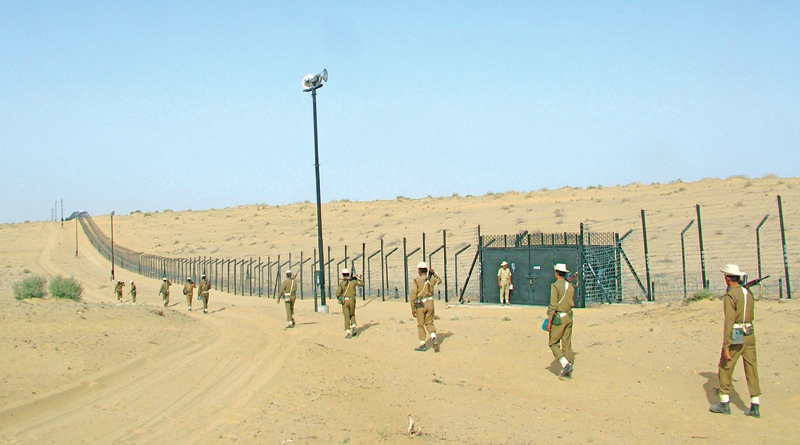The future of border management raises uneasy questions
Smruti D
For Ismael Sama, 60, the year 2021 brought in a new lease of life. Islamabad High Court had heard his prayers and ordered for his release based on a plea filed by the Indian High Commission. In 2008 Ismael had taken his cattle for grazing when he crossed over to the Pakistani side. He is a resident of Kutch’s Nana Dinara village, located approximately 60 km from Pakistan border.

Ismael’s case is not one of a kind, neither is Kutch’s proximity to Pakistan. India shares land border with Pakistan, Bhutan, Nepal, Myanmar, Bangladesh and China. The total land boundary that India has is 15,106.7km. Even as boundaries stand demarcated, most borders remain porous and the border population in these areas tend to cross over to the other side. Similarly, citizens of other countries also venture inside the Indian territory. Sarabjit Singh’s story remains known far and wide. He, a farmer, ventured into neighbouring Pakistan in 1990 while farming and was mistaken to be an Indian spy. His village, Bhikhiwind in Punjab lies just 5 km away from Punjab. He languished in jail for 23 years before being murdered by fellow inmates. Often, many innocent people are killed in custody on both sides. Usually, there is a mutual agreement on the exchange of the people arrested but the hostilities between the two nations often hinder the exchange. This free movement of individuals is because of the near porous border separating India and Pakistan. The two neighbours, who were meant to have friendly relations along with open borders, freedom of trade and travel, ended up with a fence, thereby limiting cooperation on both sides.
Only last year the government decided to erect a ‘new non-cut steel fence to plug vulnerable and infiltration-prone patches along its sensitive border with Pakistan and Bangladesh.’ These fences were to have concertina wires on top. The pilot project for this was undertaken at Silchar in Assam, along India’s border with Bangladesh. The government, under its Comprehensive Integrated Border Management System (CIBMS), is setting up ‘smart fences’ loaded with a number of gadgets and technologies to enable electronic surveillance. The idea originated from Israel and the Indian government started work in 2018. A year later, in 2019, Rajnath Singh, who was then the home minister, inaugurated the Border Electronically Dominated QRT Interception Technique (BOLD-QIT) after it was completed.
BOLD-QIT enabled the Border Security Force (BSF) to equip India-Bangladesh border of more than 4,000 km, with different kinds of sensors in the unfenced riverine area of the Brahmaputra river and its tributaries. The area with the help of this technology has been covered with data-network generated by microwave communication, optical fibre cable, digital mobile radio communication, all day surveillance cameras and most importantly, the intrusion detecting system. This project is ideal for the BSF to save 24-hour human surveillance by providing a control-room feed. From a security perspective, this system maybe state-of-the-art but from a local’s perspective it’s a major irritant. Imagine being a local, who is well-aware of the vicinity and has relatives across the border but isn’t allowed to cross over—it can certainly be so frustrating. While security threats are real and fences are a must, the truth is also that they divide the people and their land arbitrarily.
India’s borders with its different neighbours on all sides have different dynamics. One of them is varied terrains such as deserts, fertile lands, swampy marshes, snow-covered peaks and dense tropical evergreen jungles in different parts. The Indian government has spent the most resources fencing along the India and Bangladesh border.
Given the socio-political tensions that exist in South Asia, free border regime seems far-fetched. However, limiting movement also limits economic prosperity, especially in border regions, which are some of the most under-developed areas. The Indo-Pakistan international border is the most volatile among all the others given the cross-border firing, Kashmir dispute, ceasefire violations and terrorist activities that happen here. All this makes the border area one of the most unstable in the world. The most affected are the local population stretched across Gujarat, Rajasthan, Punjab and Jammu and Kashmir because the thousands of families which live on both the sides of the border cannot interact freely. Many are not able to furnish identity documents, get visas or afford a passport. This problem is common across all borders. In February 2021, the Director Generals of Military Operations (DGMOs) of both the countries held a meeting and it was announced that the two countries had agreed to ‘strictly observe all agreements on ceasefire along the Line of Control (LC) and other sectors’. A bilateral meeting in itself signifies that the two sides discuss issues and want mutual peace.
You must be logged in to view this content.

